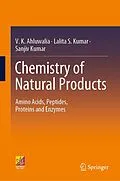This book is designed to serve as a textbook for core as well as elective courses offered to undergraduate and advanced undergraduate students enrolled in chemistry. This textbook comprehensively deals various topics of organic chemistry such as amino acids, peptides, proteins and enzymes. The text is divided into four chapters: a chapter each dedicated to amino acids, peptides, proteins and enzymes, respectively. The important reactions have been explained with the help of the mechanisms involved. It gives a detailed account of the solution phase and solid phase synthesis of peptides as well as discussing the structure and function of some biologically important peptides. It also covers the classification, nomenclature and mode of action of enzymes, and a detailed account of the structure and function of different co-enzymes. The book also includes pedagogical features like end-of-chapter exercises to aid in self learning. Given the scope, this textbook will be useful for graduate and advanced graduate students pursuing the course of chemistry, especially organic chemistry.
Autorentext
V.K. Ahluwalia has worked as professor of chemistry, University of Delhi, Delhi for more than three decades and taught postgraduate and M.Phil students. He has guided about 80 students for M.Phil/Ph.D degrees and has published more than 250 research papers in National and International Journals. He has delivered a number of invited lectures in India and Abroad. Prof. Ahluwalia worked as post-doctoral fellow for two years (1960-1962) and worked with Prof. Harold Shechter at the Department of Chemistry Ohio State University, Ohio USA and for one year (1980-81) with Professor Herbert C. Brown, Nobel Laureate at the Department of Chemistry, Purdue University, USA. He has also been a visiting professor at Dr. B.R. Ambedkar Centre for Biomedical Research University of Delhi, Delhi. Prof. Ahluwalia has authored many books a few of which are, Reaction Mechanism, Environmental Chemistry, Environmental Science, Environment Education, Environmental Pollution and Health and Organic Synthesis. His Book on Green Chemistry is the winner 2009 Choice award, being the outstanding academic title.
Lalita. S. Kumar did her PhD from University of Delhi in the year 1987 in the area of Synthetic Organic Chemistry. She has five publications to her credit. She is working as Reader at Indira Gandhi National Open University (IGNOU), New Delhi. She has been associated with design, development and maintenance of distance teaching material for over sixteen years. Her areas of interest are biochemistry, organic reaction mechanism and environmental chemistry.
Sanjiv Kumar did his PhD from University of Delhi in the year 1990 in the area of biophysical chemistry for which he worked on interaction of peptides and proteins with nuclear acids. He is working as Reader at Deshbandhu College, University of Delhi, and has a teaching experience of over sixteen years. His areas of interest are biochemistry, spectroscopy and quantum chemistry.
Inhalt
CHAPTER -1: AMINO ACIDS
1.1 INTRODUCTION
1.2 NOMENCLATURE OF AMINO ACIDS
1.2.1 Representation of Amino Acids
1.3 CLASSIFICATION OF AMINO ACIDS
1.3.1 Coded or Primary Protein Amino Acids
1.3.1.1 Nonpolar or Apolar Amino Acids
1.3.1.2 Neutral or Uncharged Polar Amino Acids
1.3.1.3 Charged Polar Amino Acids
1.3.2 Secondary and Tertiary Protein Amino Acids
1.3.3 Non-Coded or Non-Protein Amino Acids
1.3.4 Essential Amino Acids
1.4 STEREOCHEMICAL ASPECTS OF a- AMINO ACIDS
1.4.1 Absolute Configuration of a-Amino Acids1.4.1.1 The RS Notation
1.4.2 Amino Acids with Two Chiral Centres
1.5 PHYSICAL PROPERTIES OF a-AMINO ACIDS
1.5.1 General Physical Properties
1.5.2 Acid-Base Properties of Amino Acids
1.5.2.1 Amino Acids with Non-Ionisable Side Chains
1.5.2.2 Amino Acids with Ionisable Side Chains
1.5.3 Spectral Properties of a-Amino Acids
1.5.3.1 Mass Spectrometry
1.5.3.2 Nuclear Magnetic Resonance (NMR) Spectroscopy
1.5.3.3 UV Spectroscopy
1.5.3.4 IR Spectroscopy
1.5.3.4 Circular Dichroism (CD)
CONTENTS
viii Chemistry of Natural Products
1.6 CHEMICAL REACTIONS OF AMINO ACIDS
1.6.1 Reactions due to Amino Group
1.6.2 Reactions due to Carboxyl Group
1.6.3 Reactions due to both Amino and Carboxyl Groups
1.7 INDUSTRIAL PREPARATION OF a-AMINO ACIDS
1.8 CHEMICAL SYNTHESIS OF a-AMINO ACIDS
1.8.1 Enantiomeric Resolution of a-Amino Acids
1.8.2 Asymmetric Synthesis of a-Amino Acids
1.9 INDUSTRIAL AP PLICATIONS OF a-AMINO ACIDS
Exercises
CHAPTER -2 : PEPTIDES
2.1 INTRODUCTION
2.2 STRUCTURE AND CLASSIFICATION OF PEPTIDES
2.2.1 Structure of Peptide Bond
2.2.2 Classification of Peptides
2.3 NOMENCLATURE OF PEPTIDES
2.3.1 Representation of Peptides and Polypeptides
2.4 PEPTIDE SYNTHESIS
2.4.1 Protection of Amino Group
2.4.2 Protection of Carboxyl Group
2.4.3 Protection of Side Chains
2.4.4 Coupling Methods
2.5 SOLID PHASE PEPTIDE SYNTHESIS
2.5.1 Solid Phase Peptide Synthesis using
t-Boc Protection (Merrifield Approach)
2.5.2 Solid Phase Peptide Synthesis using
Fmoc Protection (Sheppard's Approach)
2.5.3 Limitations of Solid Phase Peptide Synthesis
2.6 SOME BIOLOGICALLY IMPORTANT PEPTIDES
2.6.1 Oxytocin
ix Amino Acids
2.6.2 Glutathione
2.6.2.1 Role of Glutathione in Disulphide Bond Formation
2.6.2.2 Role of Glutathione as an Antioxidant
2.6.3 Insulin
2.6.3.1 Structure Determination of Insulin
2.6.4 Bradykinin
2.6.5 Gramicidin
Exercises
CHAPTER -3: PROTEINS
3.1 INTRODUCTION 3.2 CLASSIFICATION OF PROTEINS
3.2.1 Classification on the Basis of Shape and Structure
3.2.2 Classification on the Basis of Products of Hydrolysis
3.2.3 Classification on the Basis of Biological Functions
3.3 PROPERTIES OF PROTEINS
3.3.1 Molecular Weight
3.3.2 Amphoteric Nature
3.3.3 Solubility
3.3.4 Precipitation
3.3.5 Denaturation
3.3.6 Colour Reactions
3.4 STRUCTURAL ORGANISATION OF PROTEINS
3.4.1 Covalent or Primary Structure of Proteins
3.4.1.1 Amino Acid Composition of Proteins
3.4.1.2 Amino Acid Sequence of Polypeptides
3.4.2 Conformational Aspects of Proteins: Higher Order Structures
3.4.2.1 Secondary Structure of Proteins
3.4.2.2 Tertiary Structure of Proteins
3.4.2.3 Quaternary Structure of Proteins
Exercises CHAPTER - 4: ENZYMES
4.1 INTRODUCTION
x Chemistry of Natural Products
4.2 NOMENCLATURE AND CLASSIFICATION OF ENZYMES
4.2.1 Systematic and Recommended Names
4.2.2 Classification Numbers and Code Names
4.3 CHARACTERISTICS OF ENZYMES 4.3.1 Catalytic Power
4.3.2 Enzyme Specificity
4.3.3 Enzyme Regulation
4.4
MECHANISM OF ENZYME ACTION
4.5 FACTORS AFFECTING ENZYME ACTION
4.6 CHYMOTRYPSIN: AN ENZYME IN ACTION 4.6.1 Structure of Chymotrypsin
4.6.2 Important Amino Acid Residues of Chymotrypsin
4.6.3 Mechanism of Action
4.7 COFACTORS (or COENZYMES)
4.7.1 Nicotinamide Adenine Dinucleotide (NAD+) and
Nicotinamide Adenine Dinucleotide Phosphate (NADP+)
